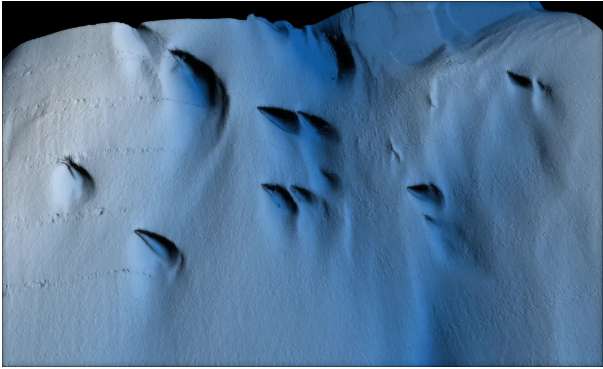“If you look closely at the shapes, they are not symmetrical, they are bent like blue clams, and the reason for this asymmetry is the rotation of the Earth,” said research leader Anna Wåhlin
Scientists have discovered never-before-seen ice formations 400 meters below an ice shelf in Antarctica. This discovery arose, according to Live Science, in an attempt by scientists to map the underside of the iceberg.
Those pieces of ice they are teardrop shaped and were located under the Dotson Ice Shelf in West Antarctica in 2022, when a remotely operated vehicle (ROV) dived 10 miles (17km) below the glacier and traveled more than 600 miles (1000km) alongside the underside of ice.
The researchers published the findings of the first-of-its-kind study Wednesday (July 31) in the journal Science Advances.
What we know about the ‘ice cycle’
“To understand the Antarctic ice cycle and how the ice moves from the interior to the surface of the ocean, we need to understand how it melts underneath. “This process is equally important as it shows how ice is created and moved from land to ocean,” she told Live Science. Anna Wåhlinhead of research and professor of oceanography at the University of Gothenburg.
The Dotson Ice Shelf is a 30-mile (50 km) wide piece of floating ice seven times the size of New York City. It is located on the coast of Marie Byrd Land in West Antarctica. It is part of the West Antarctic Ice Sheet, which “gives birth” to glaciers that could cause sea level rise of about 11 feet (3.4 meters) if they eventually lead the entire piece of the iceberg to collapse.
To further investigate the processes threatening the 1,150-foot-thick (350 m) ice shelf, researchers sent the ROV under the ice to scan the glacier’s underside with sonar, creating the most extensive and comprehensive picture of its underside glacier, that has ever been.
As scientists expected, the research showed that the glacier is melting faster in places where underwater currents are eroding its base, and debris traversing the glacier helps the piece of melted ice reach the surface.
However, quite unexpectedly, they discovered at the same time that instead of being smooth, the lower surface of the glacier is “decorated” with drops of “frozen tears”, which emerge from the peaks and valleys of the ice. Some of these shapes are about 400 meters long.
How strange shapes are created in ice
Researchers believe these strange patterns are created by uneven melting, as water moves with Earth’s rotation on the underside of the glacier.
“If you look closely the shapes are not symmetrical, are bent like blue clams, and the reason for this asymmetry is the Earth’s rotation,” Wåhlin said. “Water that moves on Earth is subject to something called Coriolis force, which acts to the left of the direction of motion in the southern hemisphere. If we are correct, there is a balance of forces in the layer closest to the ice where the friction is balanced by the Coriolis force.”
The result is a spiral flow pattern called an Ekman spiral, which occurs most often when winds travel over surface water, but can also be created by water traveling over ice.
Source: Skai
I have worked as a journalist for over 10 years, and my work has been featured on many different news websites. I am also an author, and my work has been published in several books. I specialize in opinion writing, and I often write about current events and controversial topics. I am a very well-rounded writer, and I have a lot of experience in different areas of journalism. I am a very hard worker, and I am always willing to put in the extra effort to get the job done.











